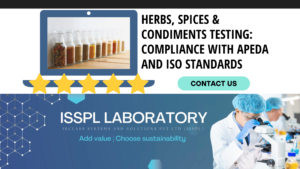An Overview by Team ISSPL - Analytical Testing Laboratory in India
ToggleIndoor air quality monitoring in the office is an effective way to improve the overall operations of the office. It is critical for the health and well-being of everyone associated with the workplace including the employees. Optimizing your indoor air quality or IAQ promotes the best practices for employee well-being and boosts productivity. The proactive approach significantly impacts the success of the operations and earns revenue for the business. On average, an employee works 40 hours per week in the office.
However, things have changed after COVID-19 and employees can enjoy a flexible remote working culture. However, the communal buildings must provide a healthy and optimal working environment for every employee.
Indoor air monitoring in the workplace
Indoor air quality monitoring in the office or an industrial plant reflects the presence of certain pollutants in the air. It could be CO2, PM2.5, and TVOCs, humidity and temperature. Sensors are apt to measure the pollutant data and help analyze the condition. One can review the pollutant level and take action to improve the air quality in the workplace. There can be severe environmental health risks with an alarming level of pollutants in the air.
Hence, IAQ must be monitored to assess the existing health risks in the office and improve the overall air quality. Monitoring the equipment to review the health-threatening pollutants including the volatile organic compounds invisible to the human eye is vital as well. There may be visible hints like musty odors, odors condensation, or ceiling condensation denoting high IAQ, and testing the air will help recognize the reason behind the pollution.
Adverse impacts on health – A step of enhanced occupational health
Air quality creates a direct and indirect impact on the lives and health of employees. The Environmental Protection Agency in the USA considers air quality an integral factor for people suffering from asthma, lung conditions, heart conditions, etc. A higher air quality can prevent the spread of airborne diseases, like – asthma. One can consider restricting the degradation of air quality to reduce the spread of health-threatening pollutants and ensure improved public health in the workplace.
Poor IAQ can trigger the following health problems –
- Respiratory illnesses
- Throat and nasal infection with a scratchy throat
- Severe lung and heart conditions
- Coughing
- Carbon monoxide poisoning
- Severe allergic reactions from Mold and mildew
- Asthma issues
- Cancer
- Fatigue and weakness
- Skin illnesses and allergies
This list goes on and there are dynamic potential health risks from poor air quality. Short-term exposure to adverse air quality can degrade your health gradually and trigger illness and disease. In contrast, long-term exposure can generate serious complications.
Increase productivity – Decrease absenteeism.
Indoor air pollution creates short and long-term health risks for everyone associated with the workplace. The typical symptoms reflecting poor indoor air quality include – irritation in the sensory organs, headache, nausea, dizziness, and fatigue. In fact, exposure to indoor air pollution can generate acute and chronic respiratory illnesses, like – asthma, lung cancer, pneumonia, hypertension, COPD (chronic obstructive pulmonary disease), Legionnaires’ disease, and humidifier fever.
Poor indoor air quality in an office can reduce productivity, increase absenteeism, etc. One can ensure a proactive solution by monitoring indoor air quality. An effective approach from the employers helps the employees enjoy clean air, free from potentially toxic chemicals and pollutants. Employers can stay assured of higher retention levels, increased productivity, and reduced absenteeism with such proactive solutions.
Keep the indoor air fresh.
The impact of poor IAQ is significant and it affects the overall health of your employees. In the long run, it gets reflected in the absence rates and productivity quotients. The airborne germs get disseminated swiftly. But it could be restricted if the air gets refreshed. It helps monitor the air temperature and humidity levels. In fact, air temperature and humidity have significant roles in the survival rate of viruses. Hence, it is essential to refresh the air inside the workplace and ensure the best solution for all.
Fight CO2 emission – Track air quality
One can realize that fresh air is necessary for optimal operational rate and performance in a workplace. Employees working in an overcrowded office or attending long meeting hours in a poorly ventilated room can get exhausted easily. Why? Because they are likely to inhale high concentrations of carbon dioxide (CO2) from the surrounding air. The adverse impacts of high levels of carbon dioxide are –
- Increased fatigue and drowsiness
- Reduced attention span and reflex
- Impaired attention span
- Overall reduction in productivity
Recognize the pollutants to keep the air quality suitable.
In workplaces and public spaces, there may be numerous pollutants circulating in the air. These may be VOCs, second-hand smoke, nitrogen dioxide, radon, lead particles, asbestos Mold, or mildew. The airborne pollutants may be organic or inorganic. It is vital to realize the source of these pollutants to beat the pollution level. One can also utilize the air quality monitoring reports to make better decisions for pollution control.
Improve the air quality with testing and measures.
The prime sources of poor indoor air quality are – poorly maintained HVAC systems, wood and coal stoves, non-vented heaters, smoke, and automotive emissions. While constructing a building, it is critical to review the materials used in construction, furniture, etc. Inadequate ventilation could be a damaging aspect and requires specialized attention. A poorly ventilated workplace can amplify the pollutant concentration and make it a toxic place for the employees.
Closing note
An efficient way of monitoring indoor air quality can facilitate the operations of your company and help eliminate systemic inefficiencies in the building. Take the best steps for the workplace and ensure a well-ventilated space.
Check the HVAC sensors, ensuring optimal configuration. Enjoy the diverse benefits of measuring and improving productivity with enhanced indoor air quality in your workplace. It is a cost-effective solution to boost employee well-being and productivity. Make the best choice for your workplace and employees.
Image by vectorjuice on Freepik







